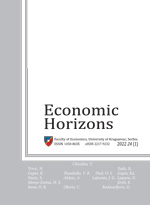
THE JOURNAL IS PUBLISHED
THREE TIMES A YEAR
in April, August and December
Wasiu Abiodun Sanyaolu1, Trimisiu Tunji Siyanbola2 and Hafeez Babatunde Makinde3
1Department of Accounting, Crescent University, Abeokuta, Ogun State, Nigeria
2Department of Accounting, Babcock University, Ilishan Remo, Ogun State, Nigeria
3Department of Business and Finance, Crescent University, Abeokuta, Ogun State, Nigeria
Credit risk is one of the biggest challenges banks in Nigeria are faced with. By implication, it is also the one with dire consequences for their operation and survival, given the fact that a series of banks’ failures have significantly been brought into connection with nonperforming loans. Thus, this study examined the bank-specific and macroeconomic determinants of the nonperforming loans of the listed Deposit Money Banks (DMBs). Regression analysis involving fixed effect was adopted in order to analyze the panel data of the 10 selected deposit money banks in the period from 2008 to 2017. The findings show that the capital adequacy ratio, the size and the loans-to-total-assets ratio negatively and significantly affect nonperforming loans, whereas profitability and age were found to significantly but positively influence nonperforming loans of the Nigerian deposit money banks. More so, the liquidity ratio negatively, but insignificantly, affects nonperforming loans. However, not a single macroeconomic variable exerts a significant effect on nonperforming loans. The study recommends that banks should always deploy strategies for credit risk management by taking cognizance of the bank-specific and economic determinants of the nonperforming loans.
Keywords:
JEL Classification:
Since March 2015, the Journal is indexed in DOAJ
Since November 2013, the Journal is indexed in ProQuest – ABI/INFORM
Since October 2013, the Journal is indexed in Cabell’s Directories
Since September 2013, the Journal is indexed in Index Copernicus Journals Master List 2012
Since March 2013, the Journal has been evaluated and accepted for listing in EconLit (American Economic Association Publications)
Since January 2013, the Journal has been included into EBSCO’s databases
Since November 2012, the Journal has been included into Ulrich’s Periodicals Directory
Since March 2015, the Journal is indexed in DOAJ
Since November 2013, the Journal is indexed in ProQuest – ABI/INFORM
Since October 2013, the Journal is indexed in Cabell’s Directories
Since September 2013, the Journal is indexed in Index Copernicus Journals Master List 2012
Since March 2013, the Journal has been evaluated and accepted for listing in EconLit (American Economic Association Publications)
Since January 2013, the Journal has been included into EBSCO’s databases
Since November 2012, the Journal has been included into Ulrich’s Periodicals Directory